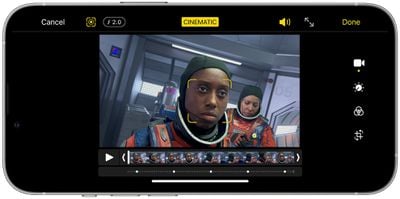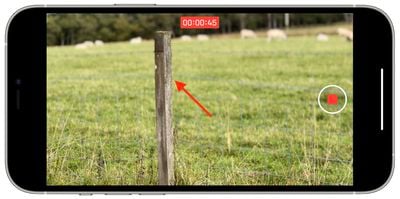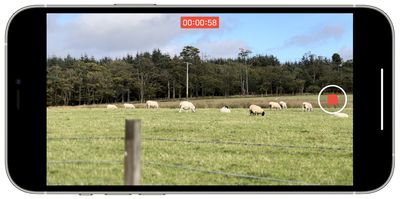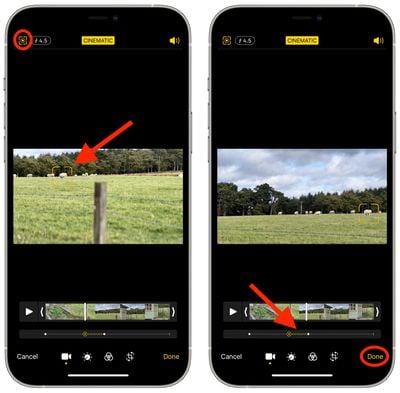With the launch of the iPhone 13 series, Apple introduced several new camera features that take advantage of the A15 Bionic processor and advanced machine learning. One of these is called Cinematic Mode. This article explains what Cinematic Mode is and how to use it.

What is Cinematic Mode?
Cinematic Mode utilizes Dolby Vision HDR and a technique called "rack focus" to seamlessly shift the focus from one subject to another when you're shooting video. It does this by locking the focus on the subject in a scene and blurring the background to achieve depth of field. If you subsequently move the camera to center on a new subject or a new subject enters the scene, Cinematic mode automatically switches the focal point to this new subject and blurs out the background.
For example, if you're shooting video of someone and then a second person enters the scene, your iPhone will intelligently adjust the surrounding blur to focus-lock on the second person. It will even automatically switch back to the initial subject if the person's face looks away from the camera, effectively generating a sophisticated professional filmmaking effect on the fly.
On iPhone 13 series models, video in Cinematic Mode can be recorded in 1080p at 30fps. Apple improved Cinematic mode for the iPhone 14 series, which can record in 4K at 30fps and 4K at 24fps using the feature.
While impressive, Cinematic Mode isn't perfect, however Apple has also made the effect fully adjustable, thanks to a post-shoot editing mode that lets you alter focal points after you've captured video. Keep reading to learn how to use Cinematic Mode on iPhone 13 and iPhone 14 models.
How to Use Cinematic Mode When Shooting Video
- Launch the Camera app on your iPhone and swipe the camera mode menu so that "Cinematic" is highlighted.

- Line up the viewfinder so that your initial subject is in shot and the focal target of the lens, then tap the Shutter button to begin recording video.

- Allow another person or object at a different distance away from the camera lens to enter the shot – your iPhone will automatically refocus when it locks onto the new subject. Tap the Shutter button again when you're done capturing video.

That's all there is to it. You can also manually select the subjects that you want to be in focus, retroactively, after you've shot your video. Here's how.
How to Adjust Cinematic Mode Focus Post-Shoot
- Launch the Photos app on your iPhone and select some video shot in Cinematic mode.
- Tap Edit in the top-right corner of the screen.
- Slide your finger along the clip reel at the bottom of the screen to find the part of the clip that you want to edit.

- Tap a different area of the shot to switch the focal point to a new subject. Note that the icon in the top-left corner of the screen is now highlighted to indicate Manual Tracking is on.
- The dotted yellow line below the clip reel indicates the amount of time in the clip that the currently selected subject is tracked. If you tap the circled dot in the line, a trash icon will appear – tap this and the tracking for this subject will be removed.

- Tap Done once you're happy with your changes.
If you've picked up an iPhone 13 or are thinking of getting one, be sure to check out the Photography Styles feature that the iPhone 13 series brings to the Camera app.





























Top Rated Comments
As for the phone, though I am drooling over this feature, I’m planning on waiting to upgrade from my 12 Pro Max until next year when I hope this feature will be available in 4K as well.
I haven't seen Apple making that claim. Especially suggesting one can be a cinematographer/photographer at the professional level simply by purchasing an iPhone. What I have seen is Apple providing a tool that will inspire many people, mostly young, to pursue making photos or movies helping them to tell stories they want to tell. In the way 15 year old Steve Spielberg did when he made a 15 minute film using his neighborhood kid friends as actors and his dad's Kodak 8mm camera.
My "rig" is simply an iPhone. It does what I want it to do for the photographs I want to make (I never use the word "take"). I have other cameras and lenses if they should be needed.
I've mentioned this before. When I bump into a photographer on the street in San Francisco, I'll often ask the question, "What do you shoot?"
If the response is something like: "I have a Canon 5D MK3 with a 24-70 f/2.8 zoom and 50mm f/1.4 lenses," that tells me something. I might reply, "Oh, that's nice!"
If the response is something like: "I make photographs of people living on the street in underserved neighborhoods for a project I'm working on," that tells me something else. That's someone I would want to talk to over a beer.
Projects and stories interest me. Not gear. Though the word boring has pretty much become hackneyed over the years, talking about gear bores me no end.
Of course an iPhone is not the proper tool for a professional studio photographer. But I can see a kid who wants to get into that and learn about gesture, posing/composition and lighting starting with an iPhone, a roll of seamless paper, and inexpensive lights.
However, 4K is the standard now for most professional video or filmmaking. 30p is also a weird frame rate for them to use. If they’re going for cinematic, they should have chosen 24p. My guess is that the effect needs more light to work and the slightly greater shutter of 30p gives it more light…
Why would you say that?
"For the camera it works for a quick and good snapshot, as it's obvious not even close to be comparable with my DSLR's."
I've found that the strength of a photograph has little to do with gear. Rather, it's about the photographer, his/her life experiences, imagination, creativity, ability to see, understanding light, being able to compose while determining what elements should be included/excluded in the frame, understanding how withholding information can create mystery, etc, etc all coming together to stir a viewer's imagination and ideally creating a supporting narrative.
I have various dSLRs, mirrorless, and Arca-Swiss 4x5 cameras. For the last ten years I've also used various iPhones, the last five years exclusively.